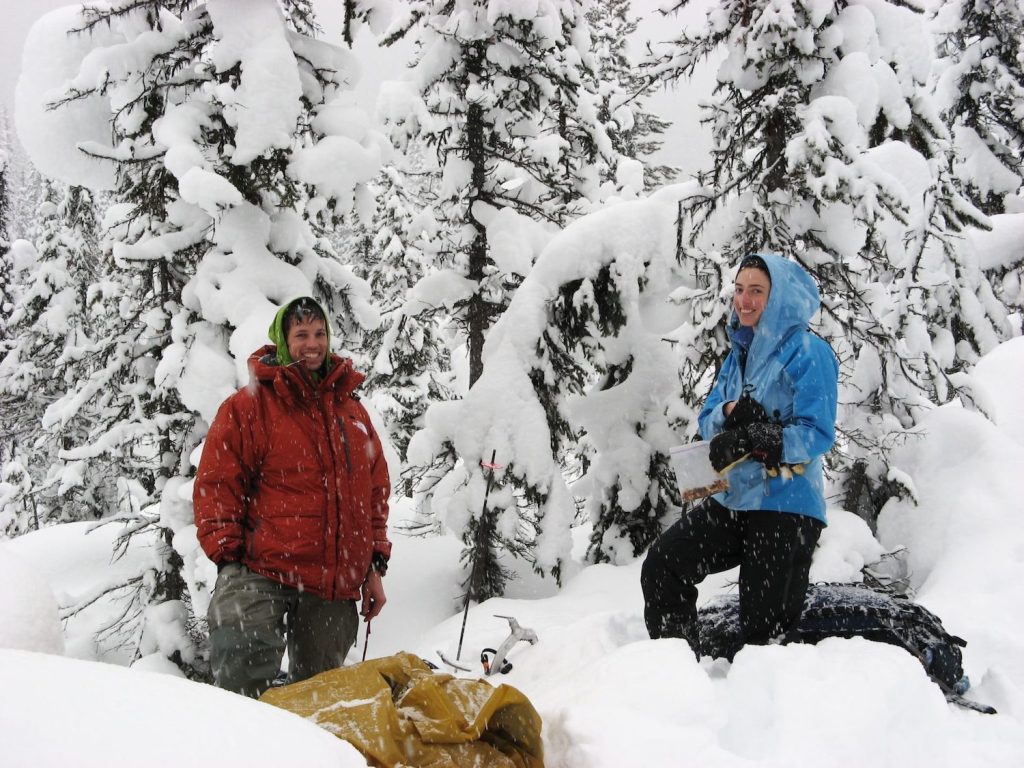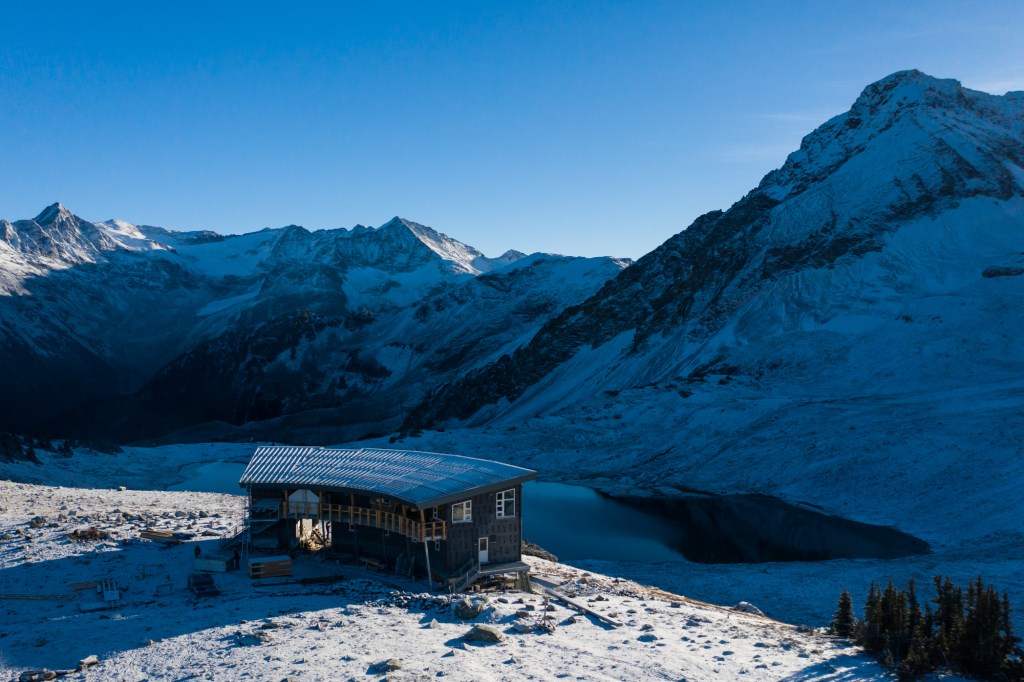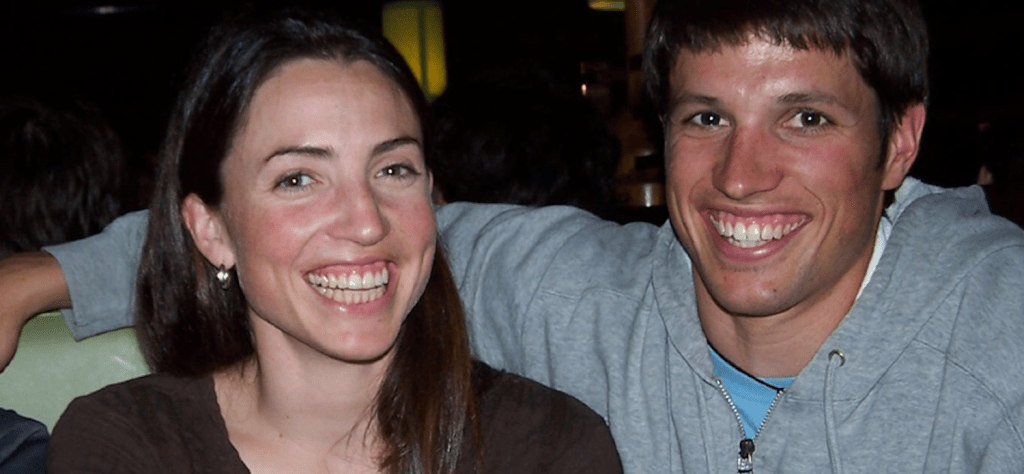Last winter, on a ski tour in the backcountry outside of Whistler, British Columbia, Julie Brenninkmeyer crested a hill and spotted the Kees and Claire Hut for the first time. The cabin—which opens to the public on September 7—is located at the base of the jagged Fissile Peak on the edge of the glacially formed Russet Lake. “You come over this rise and there’s the hut—this stunning, modern building that has this beautiful turn to it. It looks like it might take off like a bird but also that it truly belongs there,” Julie said.
She saw the hut and broke down with emotion. “I just thought, ‘My brother would have loved to ski here,’” she said. Julie’s brother was Cornelius Brenninkmeyer—he went by Kees (pronounced Case—the family comes from Dutch origins)—and the hut is named in memory of him and Claire Dixon. The couple died on January 4, 2007 while ski touring the multiday Wapta Traverse in Alberta, Canada.
For a month that winter, Claire and Kees—both experienced backcountry skiers—were volunteering as hut caretakers for the Alpine Club of Canada. When they failed to return to civilization when they had planned, their families called the authorities. Searchers from Parks Canada found their bodies in a collapsed snow cave that the couple had built on a hutless stretch of the traverse. An autopsy revealed that they died of carbon monoxide poisoning, likely from burning a small cookstove inside the snow cave without enough ventilation. Claire was 27; Kees was 25.
Shortly after they died, a fellow skier who’d met the couple in one of the huts along the Wapta Traverse reached out to the Dixon and Brenninkmeyer families. He wanted to share a photo he’d taken of the couple and tell of his encounter with them. He wrote, I enjoyed meeting them so much. They were so full of life.

Claire Dixon and Kees Brenninkmeyer died while ski touring the Wapta Traverse in 2007. (Courtesy Photo)
Building a remote, backcountry hut miles from the nearest road doesn’t happen overnight. It takes years. In this case, it took five decades.
The idea for a hut system in the Spearhead Range of British Columbia was first dreamed up in the early 1960s. This was before Whistler Blackcomb even existed. (Whistler ski resort opened first, in 1966; Blackcomb followed, in 1980.) A passionate group of ski mountaineers from the British Columbia Mountaineering Club had started ski touring around the Spearhead and Fitzsimmons Ranges, often spending days linking up traverses and sleeping in snow caves along the way.
“With such good skiing in the area, they thought it would be a great idea to put some huts in,” said Jayson Faulkner, head of the Spearhead Huts Society. In 1967, the group managed to get one hut built—a tiny, arched-roof cabin that still stands today and was designed by Werner Himmelsbach, a German-born engineer and ski mountaineer. After that, the project to build more huts in the area stalled out.
By the early 1990s, backcountry skiing was on the rise throughout North America and Faulkner was dedicated to getting more huts built in the Whistler backcountry. “I’d spent time in Europe and saw their hut infrastructure and how successful it was at getting people into the outdoors. They provided multigenerational access to alpine experiences,” said Faulkner. “We struggle with that in British Columbia. We have great mountains but bad access because there’s no infrastructure.”
So he put together a group, dubbed the Spearhead Huts Society, and they set out with the goal of building three remote, backcountry huts through Whistler’s Garibaldi Provincial Park—no easy task in a rugged and roadless area. The first hut would be constructed about eight miles outside the Whistler ski area boundary, accessed via a multi-hour hike in the summer or ski tour in the winter across the so-called Musical Bumps, rolling hills with names like Oboe and Piccolo. It took four years just to secure the permitting for the first hut, but the hut society still didn’t have the funding.
Meanwhile, after Claire and Kees died in 2007, their friends and family formed what they called the Kees and Claire Memorial Hut Society. Their goal was to get a backcountry hut built in memory of Kees and Claire. When they heard of the Spearhead Huts project, it was a perfect fit. The two groups joined forces with a common cause. The families of Claire and Kees made substantial monetary donations, and along with other public and private donors, including the Brett Carlson Memorial group and the Barbara McGeogh-Boyd family, the project, which was at last named the Kees and Claire Hut, could finally break ground. Construction began in 2017.
Volunteers at the Spearhead Huts Society hoped to build the hut over the course of two summers, but it ultimately took three, due to construction delays and limited helicopter access related to extreme wildfires in and around the park over the past few years. Many of the construction materials and labor were donated, but if they’d had to pay for it all, Faulkner estimates the build would have cost well over $2 million. Some 200 volunteers hiked in to help erect the building, and 70 companies donated supplies or labor. All of the building materials had to be flown in by helicopter. “The love and amount of sacrifice that has gone into making this building happen is really hard to overstate,” Faulkner said.
The Kees and Claire Hut is the first of three huts to be established along Whistler’s legendary Spearhead Traverse, a classic route for both hiking and skiing. The traverse, which was first skied in 1964 by Whistler local Karl Ricker, is included in the book, “50 Classic Ski Descents of North America.” The 21-mile route follows glaciated, rolling terrain along the Fitzsimmons Range and usually takes three to four days to complete. Without huts in place, most people camp or build snow caves along the way. Many consider the traverse a North American version of Europe’s famous Haute Route.
Faulkner said that through a very generous private donation, the society now has funding in place for the second of the three huts, which will be located at Mt. Macbeth, and they hope to start construction on that next summer.

It took hundreds of volunteers and years of fundraising to make the Kees and Claire Hut possible. (Photo Credit: Anthony Bonello)
Claire Dixon was a quiet and fiercely passionate young woman. Growing up in Kamloops, British Columbia, she was a talented ski racer, soccer player and water-skier throughout her younger years. She attended the University of British Columbia and studied to become a physical therapist. After their hut caretaking position, Claire and Kees planned to move to the mountain town of Revelstoke, B.C., where Claire had a job lined up at the hospital. “We used to go hiking every year with my parents. She took up backcountry skiing and she had a taste for it, a love for it,” said Claire’s brother, Paul Dixon. “She was also very calculated—she would always ski within her limits.”
On Christmas Day in 2006, about 10 days before the couple died, Claire found enough cellphone service from the top of a peak on the Wapta Traverse to make a call to her brother. He was out and missed the call, sadly, but she left a message saying she was thinking of him and his family. He still thinks about that voicemail today. Paul visited the new hut in March and was in awe of its sleek design and spectacular location. When asked what he thought Claire might think of the hut, he responded, “She would say, ‘What are you doing naming a hut after me?’ She was very modest.”
Kees Brenninkmeyer was the charming, boisterous one. With endless energy and a wicked sense of humor, he was most content when in motion. He was born in the States and later moved with his family to Ontario, Canada. In high school, he became certified as a ski instructor and taught himself how to kitesurf. School wasn’t his thing, according to his sister Julie, although he did attend college. He’d rather be in the mountains—rock climbing, skiing, mountaineering, mountain biking. In his early twenties, he decided to become a mountain guide and was working his way through the Association of Canadian Mountain Guides ski training certification. “The thing he always excelled at was being outside, slogging through something tough,” said Julie.
In 2004, Kees set off for an expedition to climb and ski Alaska’s 20,310-foot Denali, the highest peak in North America. That’s where he met Claire. The two were inseparable after that. Three years later, they decided to ski and work along the Wapta Traverse. While their lives tragically ended there, their story did not.

Claire Dixon and Kees Brenninkmeyer were working as hut caretakers when they died in a tragic accident. (Courtesy Photo)
In late August, a couple of weeks before the hut’s grand opening, Julie was hard at work trying to come up with the words for the memorial plaque to notify visitors who the hut is named for. How do you condense two young people’s lives into sentences on a single plaque? You do not. Instead, you hold onto the hope that those who step foot into the hut will be safer here than they would be outside of it. “The key thing with this hut is that it will give people a place, so they don’t have to be out in the elements. It may prevent other tragedies,” said Paul Dixon.
Julie said for visitors to the hut, there are a few things she’d like them to know about her spirited brother. “He’d always have a good joke at the dinner table and he’d always be the first up and ready to go,” she said. “He’d want you to have fun, be prepared and always go for more.”